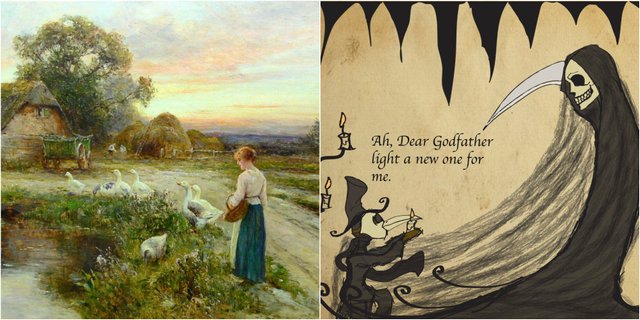Honesty and Deceit as Themes of The Goose-Girl & Godfather Death

The Goose-Girl and Godfather Death are stories written by the Brothers Grimm. They are both morality stories that admonish the virtues of honesty and demonize the vice of deceit.
However, both stories use different devices such as physical settings, introduction, characters, conflicts, and ending to promote honesty as a moral and deceit as a sin.
Setting
Stories don’t have to have elaborate settings to set the stage for a morality story. In fact, both these stories have simple settings which demonstrate that the rules of right and wrong apply anywhere and everywhere.
In Godfather Death, the only references to physical settings are the woods that Death takes the son to show him the herb that he will administer, and Death’s underground cavern.
This contrasts with the only more slightly elaborate setting for The Goose-Girl which features two kingdoms with woods and a stream between them, courtyards, royal apartments, a town and some meadows.
The relatively simple settings show that the lessons of honesty and deceit transcend time and place.
Characterization
Another aspect of the stories that are represented rather simply but very differently is the characters.
One of the stories uses biblical characters to personify quintessential characters of right and wrong, whilst the other uses real life characters to embody the same attributes.
In Godfather Death, the use of characters such as God and the Devil leave no doubt that God represents all that is good and honest, whilst the Devil represents all that is evil and deceitful.
In The Goose-Girl, the treacherous maid-in-waiting represents dishonesty whilst the innocent princess represents honesty. The use of both biblical and real life characters illustrate that lessons in honesty and deceit can be communicated just as well by symbolic and real-life characterization.
Rank and Status
Another aspect of honesty and deceit that translates well in both these stories is rank. Both stories use characters of different rank to illustrate that honesty and deceit applies to both rich and poor.
In Godfather Death, the protagonist is a poor man that becomes rich and then loses everything.
This contrasts with The Goose-Girl where the deceitful maid-in-waiting forces the princess to trade places with her. Both the rich son and the poor maid-in-waiting pay for their deceit with their lives.
Conflict
Each story uses very different conflicts to illustrate the many opportunities that exist to either do the right thing or the wrong thing. One uses the repeated treachery of a trusted maid to wrong her princess, whilst the other uses the repeated betrayal of the son to spell doom for himself.
In The Goose-Girl, the maid-in-waiting twice has the opportunity to do the right thing when the princess asks her but doesn’t.
In Godfather Death, the son betrays Death twice to his own peril. The stories are different but the lessons are the same i.e. both deception and betrayal are dishonest.
Ending
Both stories end differently but convey the same message. One story concludes with a happily-ever-after scenario whilst the other ends with a death, but both leave the reader in no doubt that living honestly is literally the only way to live.
In The Goose-Girl, the long-suffering but loyal princess eventually gets her prince and lives happily ever after.
In contrast, the son from Godfather Death dies after attempting to betray Death once too often. Whilst death is naturally sad, we aren’t left feeling any sympathy or pity for the son or the treacherous maid-in-waiting because they both had chances to do the right thing.
Both scenarios convey that honesty is rewarded whilst deceit is punished.
Happy Endings
There are many tools used in Godfather Death and The Goose-Girl to emphasize honesty and deceit. Whilst they are presented differently, they clearly illustrate that the lessons of honesty and deceit apply to everyone, everywhere, and in all situations.